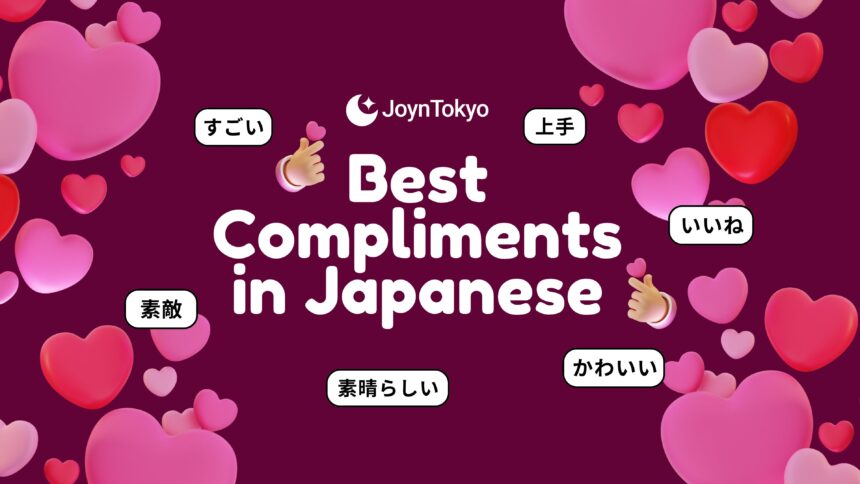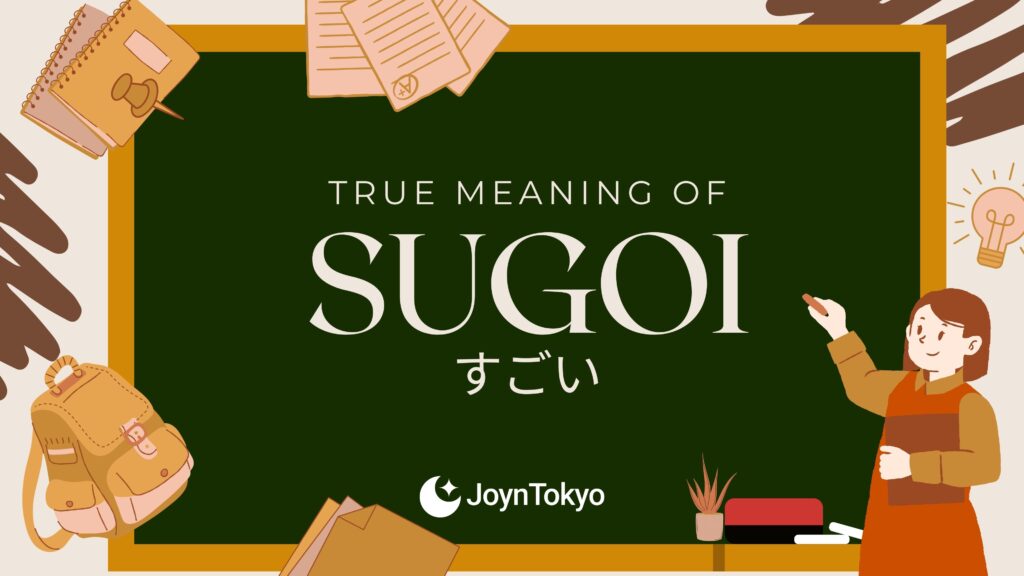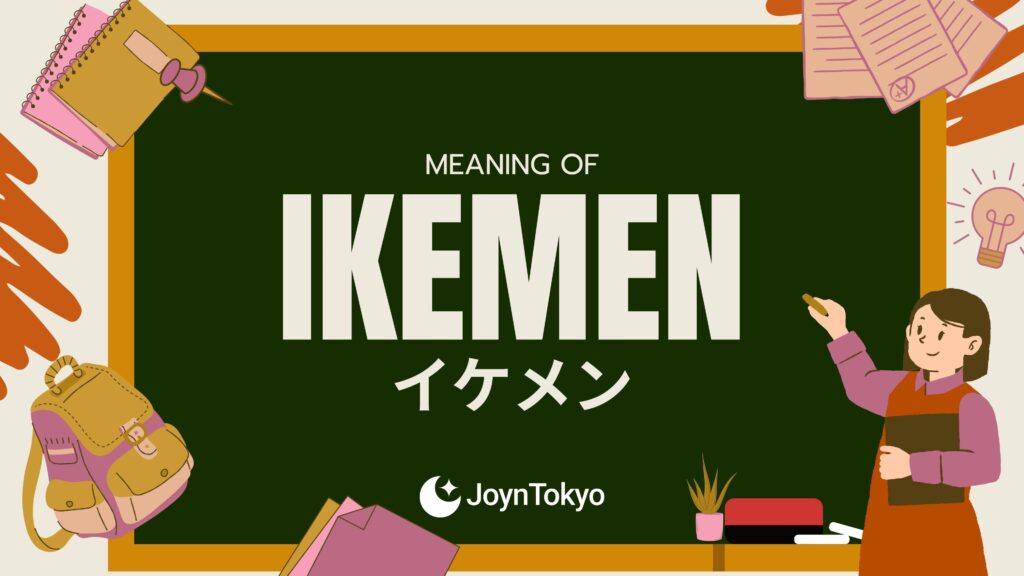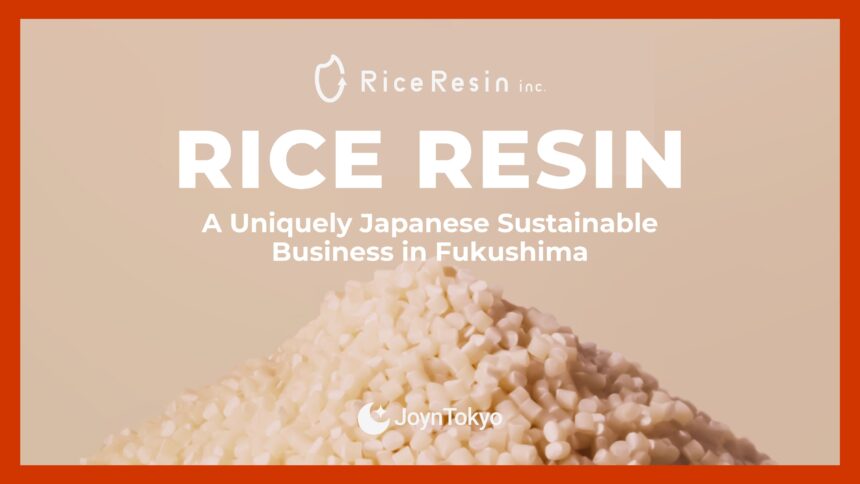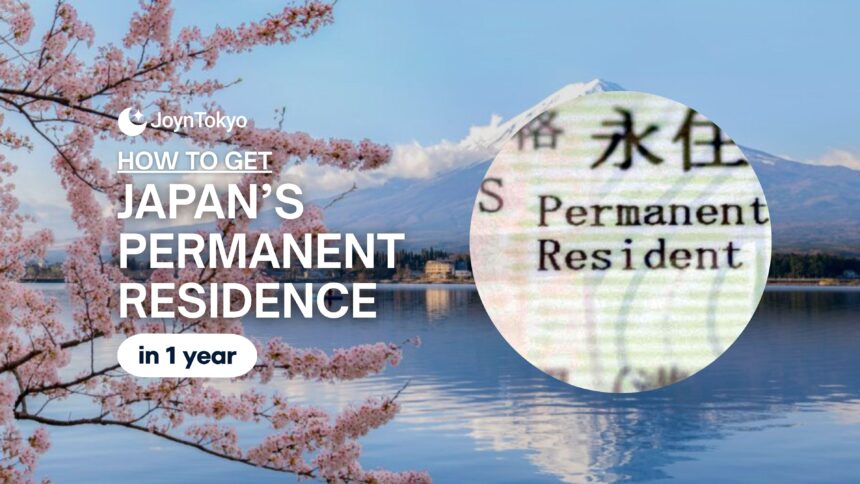Compliments are a wonderful way to connect with people in Japan, but they often carry different cultural nuances compared to Western countries. Japanese compliments are usually subtle, humble, and context-based, so learning how to use them naturally will help you build stronger relationships both in daily life and in professional settings.
This guide will walk you through common compliments in Japanese, from casual expressions to formal business phrases, along with the typical responses you’ll hear.
Everyday Compliments in Japanese
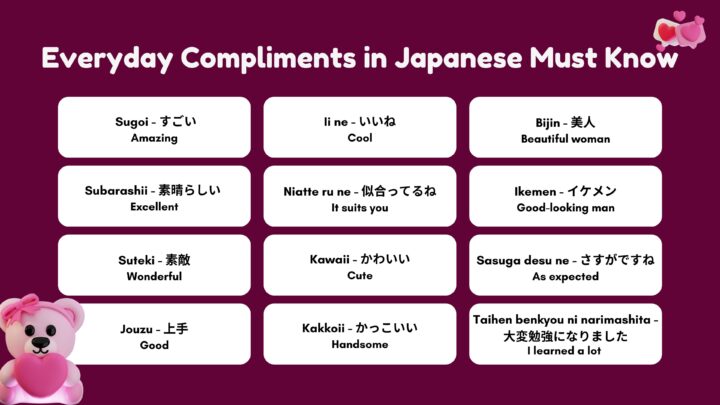
In daily conversations, Japanese people often exchange simple compliments to encourage or uplift one another. These are versatile, easy to learn, and will instantly make your Japanese sound warmer and friendlier.
1. Sugoi – すごい
This is one of the most common and versatile compliments in Japanese, meaning “amazing” or “great.” You can use it to react to surprising news, to praise someone’s ability, or simply to show admiration. Because of its flexibility, sugoi is often used casually among friends, but it can also be made more polite by adding “desu ne” at the end. Many times, especially among youths, it is shorten into “Sugo” in verbal conversations.
Examples:
| Japanese | Romaji | English |
|---|---|---|
| 日本語がすごいね。 | Nihongo ga sugoi ne. | Your Japanese is amazing. |
| このケーキ、すごいでしょう! | Kono keeki, sugoi deshou! | This cake is so delicious, right? |
Read More
2. Subarashii – 素晴らしい
This word translates as “wonderful,” “excellent,” or “splendid,” and it carries a stronger nuance than sugoi. It’s often used for achievements, performances, or creative ideas that leave a deep impression. Since it feels slightly more formal, it is also appropriate to use in professional or polite contexts. If you were confused on whether the compliment is too casual or not, use this phrase.
Examples:
| Japanese | Romaji | English |
|---|---|---|
| 素晴らしいアイディアですね。 | Subarashii aidea desu ne. | That’s a wonderful idea. |
| 昨日の試合は本当に素晴らしかった。 | Kinō no shiai wa hontō ni subarashikatta. | Yesterday’s match was truly wonderful. |
3. Suteki – 素敵
Suteki is a warm and stylish compliment often used to describe appearance, personality, or even atmosphere. It has a soft, positive feeling that makes it sound charming and friendly. By adding desu ne, it becomes more polite, making it suitable for acquaintances or formal situations.
This is a classic compliment that can be used for people, actions, objects, etc. It is more likely to be used by the young ladies or elder people, but it is also casually used among younger generations.
Examples:
| Japanese | Romaji | English |
|---|---|---|
| その服素敵だね。 | Sono fuku suteki da ne. | That outfit is lovely. |
| あなたの笑顔は素敵ですね。 | Anata no egao wa suteki desu ne. | Your smile is wonderful. |
4. Jouzu – 上手
This phrase means “you’re good at it” and is a classic compliment in Japan. It’s especially common when praising language learners, artists, or musicians for their skills. While genuine, Japanese people sometimes say it even for beginners as encouragement, so context matters when interpreting it. Commonly used term when anyone is teaching something to the other one. You can put “O” in front and say “Ojyouzu” if you want to sound more polite.
Examples:
| Japanese | Romaji | English |
|---|---|---|
| 日本語がお上手ですね。 | Nihongo ga ojouzu desu ne. | Your Japanese is good. |
| ピアノが上手だね。 | Piano ga jouzu da ne. | You play the piano well. |
5. Ii ne – いいね
This casual compliment means “That’s nice” or “Sounds good.” It’s widely used in daily conversations to show approval of an idea, plan, or object. Because of its light tone, it’s especially common among friends, making interactions feel easy-going and friendly. The “like” on social media is also called “ii ne” in Japan. So when the influencers or YouTubers asked you to give “ii ne”, that means asking to “like” the content.
Examples:
| Japanese | Romaji | English |
|---|---|---|
| その服いいね。 | Sono keikaku ii ne. | That plan sounds good. |
| 新しい機能、いいね! | Atarashii kinou, ii ne! | The new function is cool! |
Complimenting Appearance in Japanese
Appearance-based compliments are common among friends and casual acquaintances but are often expressed with modesty in Japan. Direct praise is used more carefully compared to Western cultures, so these phrases tend to feel softer and more subtle.
6. Niatte ru ne – 似合ってるね
This phrase means “it suits you” and is perfect for complimenting clothes, accessories, or hairstyles. It highlights the harmony between the person and what they’re wearing, which is a valued concept in Japanese culture. Using this phrase is a safe and polite way to compliment appearance without sounding too direct.
Examples:
| Japanese | Romaji | English |
|---|---|---|
| その帽子、似合ってるね。 | Sono bōshi, niatte ru ne. | That hat looks good on you. |
| 新しい髪型、とても似合ってますね。 | Atarashii kamigata, totemo niatte masu ne. | Your new hairstyle really suits you. |
7. Kawaii – かわいい
One of the most well-known Japanese words, kawaii means “cute.” It can be used to describe people, animals, or even objects like clothes, accessories, and characters. Since it has a friendly and positive nuance, it’s especially popular among younger people and friends. People in Japan, especially women, says kawaii almost all the time. It is normal for Japanese women to call men kawaii instead of kakkoii.
Examples:
| Japanese | Romaji | English |
|---|---|---|
| そのバッグ、かわいい! | Sono baggu, kawaii! | That bag is cute! |
| お子さんとてもかわいいですね。 | Okosan totemo kawaii desu ne. | Your child is very cute. |
8. Kakkoii – かっこいい
Kakkoii means “cool” or “handsome,” and it can describe both people and things. While it’s often used for men, it can also describe stylish outfits, cars, or actions. Among friends, it’s a casual and enthusiastic way to express admiration.
Examples:
| Japanese | Romaji | English |
|---|---|---|
| あの人、かっこいいね。 | Ano hito, kakkoii ne. | That person is cool. |
| あなたのスーツはかっこいいですね。 | Anata no sūtsu wa kakkoii desu ne. | Your suit is very stylish. |
9. Bijin – 美人
This word means “beautiful woman” and carries a more elegant and refined tone compared to kawaii. It is often used to describe women who are considered graceful or classically attractive. Because it’s more direct, it’s less common in casual situations but is often heard in formal or descriptive contexts.
Examples:
| Japanese | Romaji | English |
|---|---|---|
| 彼女は本当に美人ですね。 | Kanojo wa hontō ni bijin desu ne. | She is truly a beautiful woman. |
| あの女優は美人だね。 | Ano joyū wa bijin da ne. | That actress is beautiful. |
10. Ikemen – イケメン
This term refers to a “good-looking man” or “handsome guy.” It’s a very common and modern way of complimenting men, often used in casual settings among friends. Because of its popularity in pop culture, it’s frequently used to describe celebrities or stylish young men. This phrase is not only used for appearance but also used for actions, it contains similar meaning to gentlemen.
Examples:
| Japanese | Romaji | English |
|---|---|---|
| あの俳優はイケメンだね。 | Ano haiyū wa ikemen da ne. | That actor is handsome. |
| 店員さん、イケメンですね。 | Ten’in-san, ikemen desu ne. | The shop clerk is handsome. |
Read More
Japanese Compliments in Business
In professional environments, compliments are more formal and focus on effort, achievements, or contributions rather than appearance. Using the right phrase can show respect and build good workplace relationships.
11. Sasuga desu ne – さすがですね
This respectful phrase translates roughly as “as expected of you” and acknowledges someone’s skill or reputation. It shows admiration in a professional and culturally appropriate way, often used when someone lives up to or exceeds expectations. It is polite, positive, and frequently heard in both business and daily contexts.
Examples:
| Japanese | Romaji | English |
|---|---|---|
| さすがですね、いい結果です。 | Sasuga desu ne, ii kekka desu. | As expected, that’s a great result. |
| さすが部長、対応が早いです。 | Sasuga buchō, taiō ga hayai desu. | As expected of the manager, your response is quick. |
12. Taihen benkyou ni narimashita – 大変勉強になりました
This phrase means “I learned a great deal” and is often used after a presentation, lecture, or meeting. It’s a polite way to compliment someone’s work while also expressing gratitude for their knowledge. Using it shows humility on your part and respect toward the person you are speaking to.
Examples:
| Japanese | Romaji | English |
|---|---|---|
| この度は大変勉強になりました。 | Konotabi wa taihen benkyō ni narimashita. | Your explanation was very informative. |
| 今日の会議は大変勉強になりました。 | Kyō no kaigi wa taihen benkyō ni narimashita. | I learned a lot from today’s meeting. |
How to Respond to Compliments in Japanese
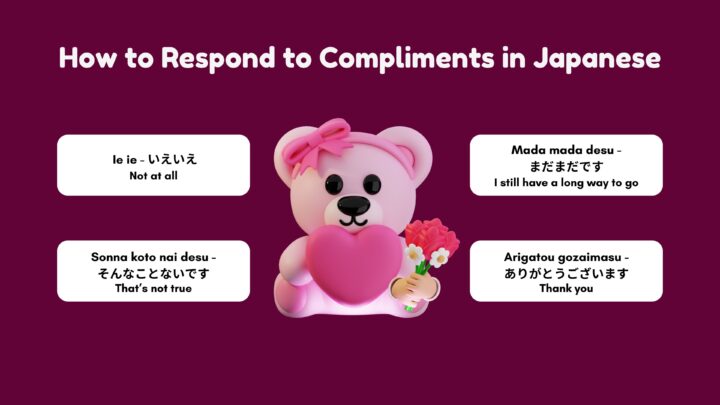
Unlike in Western cultures where people usually accept compliments with a “thank you,” Japanese people often respond with humility. This cultural habit reflects the value placed on modesty and harmony in communication. Below are the most common responses, explained with examples.
13. Ie ie – いえいえ
This response means “not at all” and is often used to deflect praise. Instead of proudly accepting the compliment, it softens the exchange by downplaying one’s achievement. It’s polite and keeps the interaction humble, making it very natural in Japanese culture. The key is to say this with a smile and say “arigato gozaimasu” right after, or it might sound a bit rude.
Examples:
| Japanese | Romaji | English |
|---|---|---|
| いえいえ、ありがとうございます。 | Ie ie, arigato gozaimasu | Not at all, thanks though. |
| いえいえ、全然です。 | Ie ie, zenzen desu. | No, not at all. |
14. Sonna koto nai desu – そんなことないです
Literally meaning “that’s not true,” this is another common way to modestly deny a compliment. It shows that you don’t want to appear arrogant, even if you appreciate the praise. Often, it’s combined with other phrases like mada mada desu to further emphasize humility. Again, better to say this with smile and positive tone of voice. With a serious tone and face, this can sound a bit provoking or angry.
Examples:
| Japanese | Romaji | English |
|---|---|---|
| そんなことないですよ。 | Sonna koto nai desu yo. | Not at all. |
| そんなことないです、まだまだです。 | Sonna koto nai desu, mada mada desu. | Not at all, I still have a long way to go. |
15. Mada mada desu – まだまだです
This phrase means “I still have a long way to go” and is a very humble way to accept a compliment indirectly. It shows that you acknowledge the praise but also emphasize your need for improvement. This makes it especially common when someone compliments skills or effort. This is very Japanese way of responding to compliments, so if you want to sound like a local, master this phrase!
Examples:
| Japanese | Romaji | English |
|---|---|---|
| まだまだです、もっと練習が必要です。 | Mada mada desu, motto renshū ga hitsuyō desu. | Not yet, I still need more practice. |
| まだまだですよ。 | Mada mada desu yo. | Not at all, I’ve got a long way to go. |
16. Arigatou gozaimasu – ありがとうございます
The most straightforward and polite way to accept a compliment, this phrase simply means “thank you.” Unlike the other responses, it acknowledges the compliment directly and shows gratitude. It’s often the safest and most appropriate reply in formal or business situations.
Examples:
| Japanese | Romaji | English |
|---|---|---|
| ありがとうございます、とても嬉しいです。 | Arigatou gozaimasu, totemo ureshii desu. | Thank you, I’m very happy. |
| 本当にありがとうございます。 | Hontō ni arigatou gozaimasu. | Thank you very much. |
Key Takeaways for Using Japanese Compliments
Compliments in Japanese are more than just nice words: they reflect cultural values like humility, respect, and appreciation of effort. In casual settings, words like sugoi, suteki da ne, ii ne, or kakkoii will make your interactions more friendly. In business, stick to professional compliments such as sasuga desu ne or taihen benkyou ni narimashita. And when receiving compliments, remember that a humble response is often the most natural.
By mastering these expressions, you’ll be able to connect more deeply with people in Japan while showing respect for their culture and communication style.

